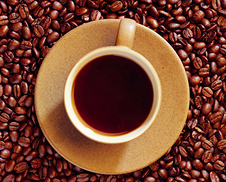A super practical method of growing flowers with coffee grounds
Follow the caf é (Wechat official account vdailycom) and found that Beautiful Cafe opened a small shop of its own.
The editor shares the method of growing flowers with coffee grounds for you. I hope it will be helpful to you!
Supplement nitrogen fertilizer
Coffee grounds can also be used as a very useful fertilizer, it can supplement nitrogen fertilizer to plants, if the leaves become light green, roots and leaves turn yellow, the stem is short and thin, and there is premature senescence, then you can use rotten coffee grounds to fertilize. (after a few weeks of sealed storage)
Slug nemesis
Slugs (slugs) hate to climb over coffee grounds, which can hurt these molluscs, while slugs and snails are very afraid of coffee grounds.
If your plant flowers are infested with these small pests, sprinkle coffee grounds around them.

Earthworm compost
Although the earthworm is also a mollusk, it is not afraid of coffee grounds. There are some coffee grounds in the soil that can help earthworms compost.
Earthworms prefer nitrogen-containing substances, which will help them reproduce better (not suitable for use in pots and not suitable for raising earthworms in flower pots), which will make the soil in the yard more fertile.
Cleaning is willing to tool
Although this is not used directly to grow flowers, it can help clean a variety of gardening tools, which is a very green and healthy way.
Because coffee grounds are abrasives, they can help clean hard-to-wash clay and dirt, which is a very good auxiliary material to wipe and rinse off.
Compost
Coffee grounds can not be poured directly into the potted soil to grow flowers, because it will slowly decompose in the soil, emitting very high calories and causing plants to burn roots.
The correct use is to compost and then use, compost is sealed fermentation, decomposition after heat dissipation can be used, composting is the best choice, more collection of fallen leaves, vegetable leaves and pericarp is the most appropriate.
Covering material
Coffee grounds are also good mulch, they can help maintain moisture in the soil, and maintain a relatively warm temperature, of course (summer is not suitable) should also be used correctly.
It has been said that directly buried next to the rhizome will hurt the root, so we need a little soil isolation, can not cover too much. (it can be kept warm and humid in winter)
Important Notice :
前街咖啡 FrontStreet Coffee has moved to new addredd:
FrontStreet Coffee Address: 315,Donghua East Road,GuangZhou
Tel:020 38364473
- Prev

Common knowledge sharing of coffee grinding and brewing
Follow Kaiping (official Wechat account vdailycom) found that when a beautiful cafe opened a small shop of its own to grind beans, the size of the powder depends on the way it is cooked. Generally speaking, the shorter the cooking time, the finer the grinding powder; the longer the cooking time, the thicker the grinding powder. In terms of actual cooking, ESPRESSO machines make coffee shops.
- Next

How to Make Coffee Easy
Pay attention to coffee reviews (Weixin Official Accounts vdailycom ) and find a good cafe to open your own shop. Now, you can use Internet search to learn to do anything, and various teaching videos and guides can be found everywhere on the Internet. So when the toilet breaks or the chair starts shaking, fix them yourself, why pay someone else to do it? Learn by yourself as
Related
- Beginners will see the "Coffee pull flower" guide!
- What is the difference between ice blog purified milk and ordinary milk coffee?
- Why is the Philippines the largest producer of crops in Liberia?
- For coffee extraction, should the fine powder be retained?
- How does extracted espresso fill pressed powder? How much strength does it take to press the powder?
- How to make jasmine cold extract coffee? Is the jasmine + latte good?
- Will this little toy really make the coffee taste better? How does Lily Drip affect coffee extraction?
- Will the action of slapping the filter cup also affect coffee extraction?
- What's the difference between powder-to-water ratio and powder-to-liquid ratio?
- What is the Ethiopian local species? What does it have to do with Heirloom native species?

